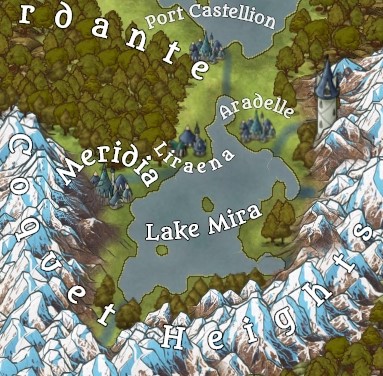History
"Miners discovered another branch of bluestone today, this will set our House up for another twenty years. I suppose I can commission a new summerhouse now." - Lord Arda, Patriarch of House Verdi
First discovered in caves in the south of the
Coquet Heights' mountain range, it appears as a thickly packed yet fine-grained soil with a blue hue, clearly a clay despite its misnomer. Given the obvious connections between blue colored material and a nation ruled by a sky goddess, this was quickly seized upon and its uses uncovered. Their first use, elaborated upon below, was as roofing tiles in the capital region of the Coquet Heights. Over time, as the social strata of Anhara evolved, this became a status symbol with only the most important or expensive structures using it. While impossible to know for sure, conjecture by historians point towards the roof of the
Vestrial Tower as an inspiration for this use. (See Vestrial Tower: Architecture)
As sources of bluestone have, thus far, only been discovered near a handful of mountains within Verdi territory, this has allowed for an easy monopoly.
House Verdi, a noble house based in the capital itself, were a minor family before their discovery of bluestone, but soon gained a path to the top. Through a cunning use of oratorical power and flattery, the Verdi family convinced Vestria herself to grant them a legal monopoly, presenting her with bluestone jewelry, thus inspiring its second use. While some sources have been depleted over time, the Verdi family monopoly has persisted.
Use
Structural
"Yet more evidence of their up-and-coming style and birth has been announced today, as the once minor House Buckler cements their new status with the purchase of a marble & bluestone manor in the Cloud District." - The Whistling Observer
As alluded to previously, the primary purpose of this material is in roofing. These tiles come in two forms, the imbrex and tegula style, and the double imbrex. The imbrex and tegula method is the earliest, with the tegulae being rectangular in shape with upturned edges on the long sides. These were placed end-to-end, with the bottom edge overlapping the top edge of the lower tile. These made up the primary surface of the roof. Over the edges of the tegulae were placed the imbrexes, curved tiles constructed for the purpose of preventing rain from seeping through.
a. The tegula b. The imbrex
The second form of roof tile, the double imbrex, is exactly what the name implies. Imbrexes are placed in rows, end to end overlapping in the same way as the tegulae above did. However, this was done with inverted imbrexes forming the bottom layer between the rows, creating a wave-like appearance. This technique developed after
The Crossing Over, as craftsmen refined their abilities over time.
The oldest structures in the Coquet Heights, but most specifically the capital given its age, can be easily recognised by the first style of construction. Later structures use the second, however cities outside the capital generally lean towards the imbrex and tegula style to give the illusion of age. That practice is frowned upon by House Verdi, as well as most capital residents, as an uncouth attempt to appear aged.
Methods of Production
These tiles were molded by craftsmen, using knife-blades for the tegulae edges, before being laid out alongside the roads in the Fog District of Meridia, the third tier of the city, so as to dry it. One might expect this to occur in the lower-level Mist district, however the chance of exposure to waterfall spray or runoff may ruin entire tiles. The tiles are then fired in a community kiln, so while drying they have a makers-mark etched into the surface by craftsmen, generally in the form of a swirl of the finger or series of intersecting lines. The occasional water droplet exceeding the Mist District's heights may leave a mark, as will stray animal footprints, during this stage.
Religious
"Our Lady Vestria today received from supplicants of the Verdi family, three necklaces and two pairs of earrings of various styles in a new 'blue stone'" - Book of Etiquette, "The Priesthood"
Unlike with the occasional exporting of bluestone tiles and its use in important structures, bluestone jewelry is confined to use by the
College of Vestrial Priestesses alone. Towards the end of the Age of Rule, the Vestrial Priestesses began codifying the rules involving said jewelry, and dictated that they may only wear styles worn by their goddess. This confined the Priestesses to bluestone earrings and necklaces, though it has also been used rarely for ornamentation within the Vestrial Tower.
Methods of Production
Bluestone works well as a material for jewelry, providing versatile and forgiving qualities needed in the art. First, the bluestone is molded in the hands until warm and thin, then flattened with a rolling pin, folded back onto itself, and repeated until at the desired level. Then, the product is placed upon ceramic tiles and formed by hand into the desired shape. The ceramic tile is then taken, with the clay still upon, and placed in a kiln for an hour at 1,900 degrees. Lastly, the jewelry is finished, after cooling, with a diamond being used to sand it down, followed by buffing until completed.
The earrings given to Vestria are kept in the Vestrial Tower



Comments